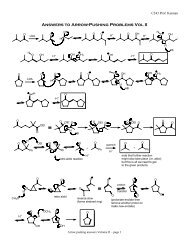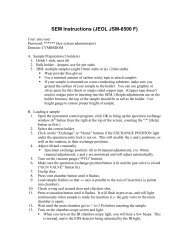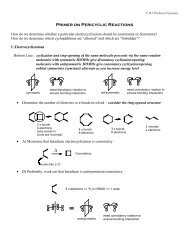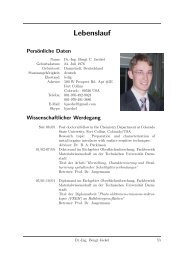Monolayer Behavior of NBD-Labeled Phospholipids at the Air/Water ...
Monolayer Behavior of NBD-Labeled Phospholipids at the Air/Water ...
Monolayer Behavior of NBD-Labeled Phospholipids at the Air/Water ...
- No tags were found...
You also want an ePaper? Increase the reach of your titles
YUMPU automatically turns print PDFs into web optimized ePapers that Google loves.
5544 Langmuir, Vol. 18, No. 14, 2002 Tsukanova et al.<br />
one goes from phosph<strong>at</strong>idylethanolamine to phosph<strong>at</strong>idylcholine<br />
through <strong>the</strong> addition <strong>of</strong> methyl groups: <strong>the</strong><br />
former phospholipid was found to bind 7-12 w<strong>at</strong>er<br />
molecules, while values ranging from 30 to 35 w<strong>at</strong>er<br />
molecules per phospholipid were reported for <strong>the</strong> l<strong>at</strong>ter. 43<br />
Due to <strong>the</strong> presence <strong>of</strong> <strong>the</strong> <strong>NBD</strong> chromophore, a larger<br />
headgroup size will likely favor a fur<strong>the</strong>r increase in<br />
hydr<strong>at</strong>ion. Never<strong>the</strong>less, comparing <strong>the</strong> hydr<strong>at</strong>ion potentials<br />
<strong>of</strong> phosph<strong>at</strong>idylethanolamine and phosph<strong>at</strong>idylcholine,<br />
large changes in hydr<strong>at</strong>ion give rise to a value <strong>of</strong><br />
µ H2O/ɛ H2O equivalent to an increase in ∆V <strong>of</strong> ∼31 mV. Hence,<br />
considering th<strong>at</strong> this simplific<strong>at</strong>ion leads to some underestim<strong>at</strong>ion<br />
<strong>of</strong> group dipole contributions, we choose to<br />
neglect changes in µ H2O/ɛ H2O due to <strong>NBD</strong> incorpor<strong>at</strong>ion in<br />
<strong>the</strong> phospholipid structure in our calcul<strong>at</strong>ions as rel<strong>at</strong>ively<br />
insignificant. Then, we will consider th<strong>at</strong> for a given<br />
temper<strong>at</strong>ure, pH and area per molecule <strong>the</strong> contributions<br />
<strong>of</strong> µ CH3 /ɛ CH3 and <strong>of</strong> µ CdO /ɛ CdO to ∆V are identical to those<br />
pertaining to <strong>the</strong> DPPE monolayer. 20 Thus, we may ascribe<br />
differences in <strong>the</strong> surface potentials <strong>of</strong> DPPE and DPPE-<br />
<strong>NBD</strong> mainly to <strong>the</strong> substitution <strong>of</strong> two phosph<strong>at</strong>idylethanolamine<br />
headgroup protons by <strong>the</strong> <strong>NBD</strong> chromophore.<br />
Then, we may write, after <strong>the</strong> subtraction <strong>of</strong> eq 1<br />
from eq 2<br />
µ <strong>NBD</strong> /ɛ <strong>NBD</strong> ) ɛ 0 A(∆V DPPE-<strong>NBD</strong> - ψ 0 - ∆V DPPE ) (3)<br />
where ψ 0 is <strong>the</strong> double-layer potential <strong>of</strong> <strong>the</strong> DPPE-<strong>NBD</strong><br />
monolayer. On <strong>the</strong> basis <strong>of</strong> <strong>the</strong> intrinsic pK a <strong>of</strong> <strong>the</strong><br />
phosph<strong>at</strong>idylethanolamine headgroup, DPPE can be<br />
considered as a zwitterion bearing a permanent positive<br />
charge on <strong>the</strong> amine group and a neg<strong>at</strong>ive charge on <strong>the</strong><br />
phosph<strong>at</strong>idyl group over a pH range <strong>of</strong> 2.3-8. 36 As a result,<br />
<strong>the</strong> contribution <strong>of</strong> <strong>the</strong> ψ 0 potential in ∆V DPPE , in particular,<br />
<strong>at</strong> pH 5.6 will be negligible.<br />
To calcul<strong>at</strong>e µ <strong>NBD</strong> /ɛ <strong>NBD</strong> using eq 3, <strong>the</strong> ψ 0 potential <strong>of</strong> <strong>the</strong><br />
DPPE-<strong>NBD</strong> monolayer should be determined. As suggested<br />
by Dynarowicz-L<strong>at</strong>ka et al., 44 a portion <strong>of</strong> ∆V<br />
associ<strong>at</strong>ed with <strong>the</strong> double-layer potential can be found<br />
through a comparison <strong>of</strong> <strong>the</strong> surface potentials <strong>of</strong> a<br />
nonionized DPPE-<strong>NBD</strong> monolayer on an acidic subphase<br />
and an ionized one on pure w<strong>at</strong>er. Given an intrinsic pK a<br />
<strong>of</strong> 0.32-0.7 for <strong>the</strong> phosph<strong>at</strong>idyl group 36 and taking into<br />
account <strong>the</strong> ioniz<strong>at</strong>ion properties <strong>of</strong> <strong>the</strong> <strong>NBD</strong> chromophore,<br />
1,10 it is reasonable to expect th<strong>at</strong> <strong>the</strong> PE - -<strong>NBD</strong><br />
group will be completely neutralized by a proton, probably<br />
in <strong>the</strong> form <strong>of</strong> an ion pair, <strong>at</strong> a subphase pH e 2. Thus,<br />
to obtain <strong>the</strong> dependence <strong>of</strong> <strong>the</strong> ψ 0 potential on <strong>the</strong> area<br />
per molecule for <strong>the</strong> DPPE-<strong>NBD</strong> monolayer on pure w<strong>at</strong>er,<br />
<strong>the</strong> ∆V-A iso<strong>the</strong>rm <strong>of</strong> <strong>the</strong> DPPE-<strong>NBD</strong> monolayer spread<br />
onto a subphase containing HCl <strong>at</strong> a pH <strong>of</strong> 1.9 was<br />
measured (curve c in Figure 5) and, <strong>the</strong>n, subtracted from<br />
<strong>the</strong> ∆V-A iso<strong>the</strong>rm shown in Figure 5A (curve a). The<br />
dependence <strong>of</strong> <strong>the</strong> ψ 0 potential on <strong>the</strong> area per molecule<br />
is presented in Figure 5B. The fact th<strong>at</strong> <strong>the</strong> resulting ψ 0<br />
potential does not obey <strong>the</strong> exponential dependence<br />
predicted by <strong>the</strong> Gouy-Chapman model is worth special<br />
<strong>at</strong>tention and will be discussed below. Since values <strong>of</strong> <strong>the</strong><br />
ψ 0 potential <strong>of</strong> <strong>the</strong> DPPE-<strong>NBD</strong> monolayer <strong>at</strong> <strong>the</strong> air/w<strong>at</strong>er<br />
interface <strong>at</strong> different areas per molecule can be obtained<br />
from Figure 5B, <strong>the</strong> value <strong>of</strong> µ <strong>NBD</strong> /ɛ <strong>NBD</strong> can be readily<br />
assessed using eq 3. In <strong>the</strong> 0.6-0.4 nm 2 /molecule region,<br />
eq 3 yields µ <strong>NBD</strong> /ɛ <strong>NBD</strong> ≈ -0.23 D (to convert <strong>the</strong> calcul<strong>at</strong>ed<br />
value <strong>of</strong> µ <strong>NBD</strong> /ɛ <strong>NBD</strong> into Debye units, <strong>the</strong> conversion factor<br />
1D) 3.335 × 10 -30 C‚m was applied 29 ). We stress th<strong>at</strong>,<br />
although <strong>the</strong> absolute value <strong>of</strong> µ <strong>NBD</strong> /ɛ <strong>NBD</strong> might be underestim<strong>at</strong>ed<br />
due to <strong>the</strong> simplific<strong>at</strong>ion <strong>of</strong> our analysis,<br />
(43) Sen, A.; Hui, S.-W. Chem. Phys. Lipids 1988, 49, 179.<br />
(44) Dynarowicz-L<strong>at</strong>ka, P.; Dhanabalan, A.; Cavalli, A.; Oliveira, O.<br />
N., Jr. J. Phys. Chem. B 2000, 104, 1701.<br />
<strong>the</strong> contribution <strong>of</strong> µ <strong>NBD</strong> /ɛ <strong>NBD</strong> to ∆V was indeed found to<br />
be neg<strong>at</strong>ive, which is not unreasonable as explained below.<br />
The <strong>NBD</strong> heterocyclic chromophore is fl<strong>at</strong> and, because<br />
<strong>of</strong> <strong>the</strong> distribution <strong>of</strong> charges in its structure, bears a<br />
permanent electric dipole moment oriented as drawn<br />
schem<strong>at</strong>ically in Figure 6a, making an angle <strong>of</strong> 43° with<br />
respect to <strong>the</strong> N-NO 2 axis. 41 With this model, it is thus<br />
possible to discuss <strong>the</strong> orient<strong>at</strong>ion <strong>of</strong> <strong>the</strong> dipole moment<br />
MB <strong>at</strong> <strong>the</strong> air/w<strong>at</strong>er interface on <strong>the</strong> basis <strong>of</strong> <strong>the</strong> ∆V d<strong>at</strong>a<br />
analysis. Recent calcul<strong>at</strong>ions 29,36 showed th<strong>at</strong> a positive<br />
portion <strong>of</strong> ∆V <strong>of</strong> <strong>the</strong> DPPE monolayer origin<strong>at</strong>es from two<br />
main dipole moments: µ CH3 th<strong>at</strong> characterizes <strong>the</strong> aliph<strong>at</strong>ic<br />
chain terminal group and µ CdO corresponding to <strong>the</strong><br />
carbonyl CdO group <strong>of</strong> <strong>the</strong> phospholipid molecule. Structural<br />
studies on phospholipid monolayers and bilayers 36<br />
indic<strong>at</strong>ed th<strong>at</strong> both dipoles in a closely packed st<strong>at</strong>e were<br />
oriented essentially parallel to <strong>the</strong> surface normal with<br />
<strong>the</strong>ir strong projected dipole moments µ CH3 and µ CdO<br />
directed into <strong>the</strong> monolayer (see Figure 6b), thus contributing<br />
positively to <strong>the</strong> surface potential. By contrast,<br />
<strong>the</strong> phosph<strong>at</strong>idylethanolamine dipole with its ethanolamine<br />
group slightly repelled away from <strong>the</strong> monolayer<br />
toward <strong>the</strong> w<strong>at</strong>er subphase gives <strong>the</strong> projection µ PE onto<br />
<strong>the</strong> surface normal antiparallel to µ CH3 and µ CdO as shown<br />
in Figure 6b. As a result, it contributes neg<strong>at</strong>ively to <strong>the</strong><br />
surface potential. 29,36 Consequently, <strong>the</strong> neg<strong>at</strong>ive µ <strong>NBD</strong> /<br />
ɛ <strong>NBD</strong> value implies th<strong>at</strong> <strong>the</strong> orient<strong>at</strong>ion <strong>of</strong> <strong>the</strong> <strong>NBD</strong> dipole<br />
moment MB <strong>at</strong> <strong>the</strong> air/w<strong>at</strong>er interface must be similar to<br />
th<strong>at</strong> <strong>of</strong> <strong>the</strong> phosph<strong>at</strong>idylethanolamine dipole. Therefore,<br />
any orient<strong>at</strong>ion <strong>of</strong> <strong>the</strong> <strong>NBD</strong> group as shown in Figure 6c<br />
may be ascribed to <strong>the</strong> <strong>NBD</strong> chromophore in <strong>the</strong> DPPE-<br />
<strong>NBD</strong> monolayer as long as <strong>the</strong> projection µ <strong>NBD</strong> on <strong>the</strong><br />
surface normal remains neg<strong>at</strong>ive. As shown in Figure 6b,<br />
<strong>the</strong> depiction with <strong>the</strong> <strong>NBD</strong> chromophore loc<strong>at</strong>ed underne<strong>at</strong>h<br />
<strong>the</strong> phosph<strong>at</strong>idylethanolamine group is consistent<br />
with <strong>the</strong> conclusion derived from <strong>the</strong> π-A iso<strong>the</strong>rm: <strong>the</strong><br />
<strong>NBD</strong> group does not require any additional area in <strong>the</strong><br />
condensed monolayer. Indeed, given <strong>the</strong> size <strong>of</strong> <strong>the</strong> <strong>NBD</strong><br />
group (approxim<strong>at</strong>ely 0.6 nm × 0.5 nm in <strong>the</strong> plane and<br />
0.025 nm thick 45 ), such a localiz<strong>at</strong>ion (Figure 6b) will not<br />
alter <strong>the</strong> area per molecule in <strong>the</strong> condensed st<strong>at</strong>e to any<br />
remarkable extent because <strong>the</strong> area <strong>of</strong> ∼0.125 nm 2<br />
required per <strong>NBD</strong> is sufficiently small to be readily<br />
accommod<strong>at</strong>ed underne<strong>at</strong>h <strong>the</strong> phosph<strong>at</strong>idylethanolamine<br />
headgroup.<br />
Following a similar approach, <strong>the</strong> contribution <strong>of</strong> <strong>the</strong><br />
<strong>NBD</strong> chromophore to <strong>the</strong> surface potential <strong>of</strong> <strong>the</strong> <strong>NBD</strong>-<br />
(C 12 )-PC monolayer was also estim<strong>at</strong>ed. Comparing <strong>the</strong><br />
∆V-A iso<strong>the</strong>rm <strong>of</strong> <strong>the</strong> <strong>NBD</strong>(C 12 )-PC monolayer (curve b,<br />
Figure 5A) and th<strong>at</strong> <strong>of</strong> <strong>the</strong> parent phospholipid (curve d,<br />
Figure 5A), <strong>the</strong> <strong>at</strong>tachment <strong>of</strong> <strong>the</strong> <strong>NBD</strong> chromophore<br />
terminally to an aliph<strong>at</strong>ic chain notably causes a decrease<br />
in ∆V <strong>of</strong> 320 mV. As <strong>the</strong> headgroup <strong>of</strong> both monolayerforming<br />
compounds is phosph<strong>at</strong>idylcholine completely<br />
ionized <strong>at</strong> pH 5.6 used in <strong>the</strong> experiments, <strong>the</strong> presence<br />
<strong>of</strong> both DPPC and <strong>NBD</strong>(C 12 )-PC <strong>at</strong> <strong>the</strong> interface in<br />
zwitterionic form rules out <strong>the</strong> possibility for <strong>the</strong> doublelayer<br />
ψ 0 potential to alter <strong>the</strong> monolayer ∆V. Moreover,<br />
both monolayers collapse <strong>at</strong> approxim<strong>at</strong>ely <strong>the</strong> same area<br />
per molecule, so th<strong>at</strong> <strong>at</strong> <strong>the</strong> end <strong>of</strong> <strong>the</strong> iso<strong>the</strong>rm <strong>the</strong><br />
terminal CH 3 group, <strong>the</strong> carbonyl, and <strong>the</strong> phosph<strong>at</strong>idylcholine<br />
dipole moments <strong>of</strong> <strong>the</strong> DPPC and <strong>NBD</strong>(C 12 )-<br />
PC molecules are probably all projected alike onto <strong>the</strong><br />
surface normal. Consequently, <strong>the</strong> contributions µ CH3 /ɛ CH3 ,<br />
µ CdO /ɛ CdO and µ PC /ɛ PC as well as <strong>the</strong> contribution <strong>of</strong> <strong>the</strong><br />
oriented w<strong>at</strong>er dipoles, µ H2O/ɛ H2O,to∆V <strong>of</strong> both monolayers<br />
are almost identical <strong>at</strong> a given temper<strong>at</strong>ure, pH, and area<br />
per molecule. 20 Then, <strong>the</strong> decrease in ∆V <strong>NBD</strong>(C12)-PC com-<br />
(45) Flament, C.; Graf, K.; Gallet, F.; Riegler, H. Thin Solid Films<br />
1994, 243, 411.











